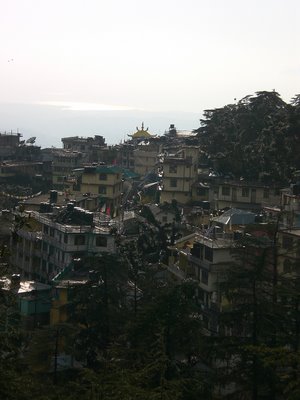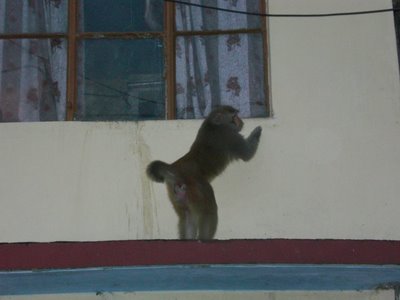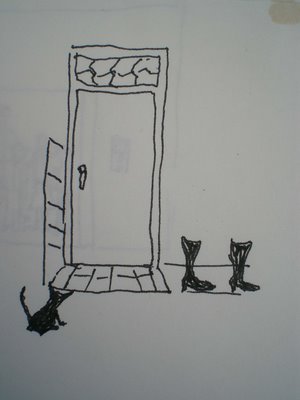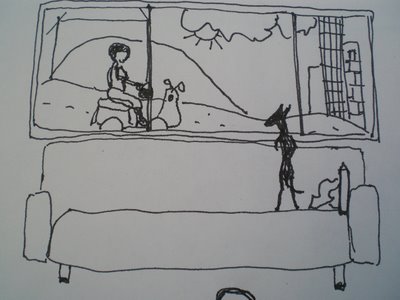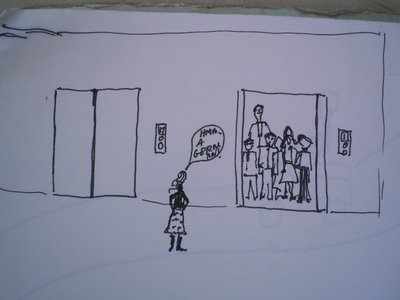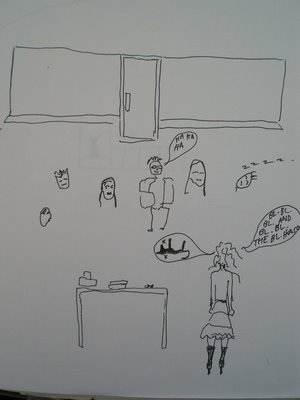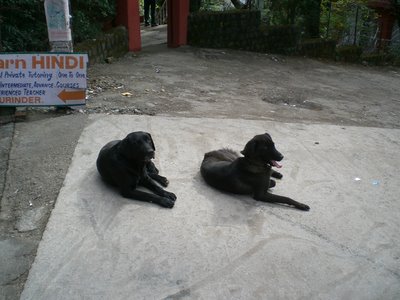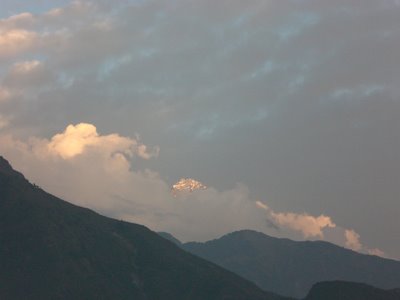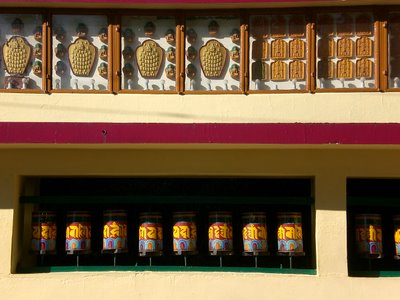The Caves

When I hear the word cave, I think of a place black and damp, completely without access to light and full of echoes, something like the cave of Plato’s prisoners, chained to a wall, naming shades and shadows as seriously as if they were solid objects, taking echoes to be speech. I gave a cursory glance to the Ajanta and Ellora caves on the internet; I read there were some carvings and paintings, and I think I imagined them the way I imagine the caves at Lascaux, cold, inaccessible places with impressively ancient pigments adhering miraculously to rough walls, suggesting but never fully revealing another man, from another time.
I went from Dharamshala to Delhi to Mumbai, and from Mumbai, I caught a train to Aurangabad, which is a very small city inland from Mumbai and a good base camp for exploring the caves. On the train, I sat across from a young Indian named Samson and an aging lecturer on botany at a local college. (Samson, once in the navy, is now a competitive bodybuilder. I know, it's too good to be true. I'm really not making it up.) Near the end of the journey, the botanist pointed to a white man several benches away, near a window. I hadn’t even noticed him before, but the professor asked me if he was my husband. When I answered with a laugh in the negative, the botanist then inquired whether the man was my brother.
When the train reached Aurangabad the other white person in the car and I exited, and as we left the platform, I approached him and told him we’d been taken for siblings. We laughed, we bantered, we left the station together, and like any good brother and sister, we joined forces in fighting off the inevitable post-transportation tout attack. Eventually, we checked into the same shabbilly comfortable hotel, and later that night, we had dinner together. We found that we both wanted to visit the Ellora caves, and so the next morning we hired a rickshaw together and set of on the bumpy one-hour journey.
The caves of Ellora are indeed dark, cool, and made entirely of rock, but that is where their meeting with my vague expectations ends. Rather than a series of holes separated from light and air by a long tunnel, they are a series of 34 magnificent temples and monasteries, their entrances, interiors, and fine carvings wrested from a vertical face of rock over a period of 700 years. The first 12 structures are Buddhist, dating from 400-700 A.D., the next 17 are Hindu, dating from 600-700 A.D, roughly, and the last 5 are Jain temples, dating from 800-1100 A.D.
Between the parking lot and the site entrance there are countless hawkers selling jewelry, geodes, antique coins, guide services, and guidebooks. I bought the slimmest volume and sat down for a pre-sightseeing Nescafe with Glen (my husband from the train). The book contained a map from which I gathered the construction timetable and layout of the site; the first caves in temporal terms were the last caves in physical relation to the entrance of the complex, so we walked past all the Hindu caves before entering the first of the Buddhist. Except for the entrance, open and admitting light, the first of the Buddhist excavations is cave-like indeed, small and unadorned, with eight cells, presumably quarters for monks, ranged about its sides. The next is deep, and wide, supported by row upon row of solid pillars, centering on an enormous Buddha seated on a lion throne, somehow reminiscent of a Pharaoh, and decorated all around its square walls by Bodhisattvas and lotuses.
The caves are all mixed up in my mind by now, leaving one dimly lit, collected impression. I could pull widths and heights from that slender guidebook, which I still have, but that book bores me, so why should I bore myself by boring you with what bores me. There is no use in trying to reconstruct the caves here through locations and dimensions, so I'll try to use impressions in the place of numbers.
It may have been the second, or the fourth cave. Anyhow, it was one of many with columns leading to a giant Buddha radiating both peace and power from a recessed throne; but this one was slightly different. The sitting place of the central Buddha in this particular cave (as with many of them) is a room all its own. As I exited this central recess I turned right, intending to take the wide, square route to the exit, but I saw a patch of darker darkness, so far back in shadow as to be easily missed. I took a long step up a stone stair, worn smooth and warped in the center by centuries of feet. Stepping over a similarly worn threshold I found myself in a spot of nearly complete darkness, or rather, highly filtered light, light tasting as diluted as a cup of tea brewed from a bag already used 5 times. The room is rectangular, and it must have been about 7 feet high, 12 feet long, and 7 feet wide. I stood appreciating the way the perpendicular rectangle of light from the doorway, already so weakened by its journey from the far away front of the temple, cast a moonlight rectangle on the floor. That light stopped completely at its outline, not a drop seeping into the surrounding darkness. After a while, it occurred to me to try sound. I uttered a syllable, “Ah,” and listened to its reverberations spend several seconds crawling about the chamber. Then, wanting to experiment more with the phenomenon, I sang two verses, and one line from another verse, of My Favorite Things.
Raindrops on roses and whiskers on kittens
Bright copper kettles and warm woolen mittens
Brown paper packages tied up with strings
These are a few of my favorite things
When the dog bites
When the bee stings
When I'm feeling sad
I simply remember my favorite things
And then I don't feel so bad
Silver white winters that melt into springs
These are a few of my favorite things

For some reason completely hidden to me, these are the musical lines that offer themselves whenever I am in need of a song to sing, and on my first attempt I sung them all the way through, at the usual rhythm. As I sung one line, the previous one remained in the room, and by the middle of my song, a ringing of overlapping tones formed a kind of mattress, almost smothering my voice. I wanted to hear the reverberations distinctly, so during my next attempt I took long pauses between each word, letting the cave's reaction to the previous word end before beginning the next. The chamber did not exactly echo my words, or even my tones, rather it rolled them over its hard, glossy surface and returned them transformed, into what I can’t say.
The words of my song were inappropriate to the cavern’s acoustics. Possibly, any word in a language I understand, anything that could lead to meaning, finitude, comprehensibility, separation of one thing from another, would have been strange there, deep in the belly of the world. In the end, I paced through the lines sound by sound, letting each syllable issue, transform, and exhaust its energy before producing another, till their only meaning was their existence. The symbolism of the caves, the meanings intended by their makers, will never be a part of my experience; but the rock itself remains, and I knew for a few moments being without thought or intent, just action and reaction according to nature, giving and taking sounds.
By the time I emerged from the chamber Glen had gone on to another cave, which is probably for the better as he might have found the sounds issuing from within a little strange. Some time later, walking from one cave to the next, he mentioned that this must have been where the crucial scene of A Passage to India (an English woman is raped by an Indian boy, according to him) was set. It was a passing comment, but I sometimes approach reading in the same way I approach travel: I wait for something interesting and somehow relevant to put itself in my path. So, a few weeks later, when I ran across the book here in Goa, I bought it and began to read, expecting some further insight into the caves of Ellora. I noticed almost immediately, by the description of the landscape, that the place couldn’t be the same, and upon further research, I found that the location, Chandrapore and the Marabar hills, are fictional places representing another region of India.
Nonetheless, it was a good lead. There’s no way I could read anything but a novel here on a beach in Goa. E.M. Forster is a carefull weaver of character and nature, and although the caves of his imagination are really caves, not pillared halls but holes in hills, they have given me a point of reference. The impetus of the novel does indeed take place in the caves of Marabar (although not at all in the way Glen thought), and the particular echo of the caves have effects on certain characters which resonate throughout the novel. An old woman, Mrs. Moore, hears the echo, and not too long afterward, she dies. The narrator says of its affect on her:
“the echo began in some indescribable way to undermine her hold on life. Coming at a moment when she chanced to be fatigued, it had managed to murmur: ‘Pathos, piety, courage- they exist, but are identical, and so is filth. Everything exists, nothing has value.’ If one had spoken vileness in that place, or quoted lofty poetry, the comment would have been the same- ‘ou-boum’. If one had spoken with the tongues of angels and pleaded for all the unhappiness and misunderstanding in the world, past, present, and to come, for all the misery men must undergo whatever their opinion and position, and however much they dodge or bluff- it would amount to the same, the serpent would descend and return to the ceiling.”
Nature (and by nature I mean anything that isn't me), in life and in fiction, offers us concrete objects to illustrate, or externalize our interior lives. My own internal life being, well, let's call it involving, there's only so much sightseeing I can do in a day. It takes an effort to connect to an object in a way that is more than superficial or acquisitive, and so, by the end of the Buddhist caves and the middle of the Hindu caves, I had done all I could for a time. Glen had also had enough, so we headed back to Aurangabad, and I resolved to come back to Ellora in a few days to give the remaining structures their due. We had dinner again that night, and then we had drinks and talked for a few hours in the hotel courtyard.
Glen is in his early 40’s and single. He’s reasonably fit and attractive. He has spent the last 10 years doing import/export inspections contracting (no, I don’t really know what that is either) in North Africa and the Middle East. He spent 2 years in Iraq and left at the start of the war. He’s from New Zealand. He owns a nice little home in Auckland, where he plans to return and settle after 6 months of travel. The strange thing about our meeting, and probably the only reason I remember his name, is that he never asked mine, and I never asked his. Early on in our acquaintance, I thought to ask, but some imp put it in my mind to wait; I was curious to see just how long it would take him to wonder about this detail. So, dinner, breakfast, a day of sightseeing, more dinner, drinking, and the question never came. After dinner and before drinking, he showed me pictures of his India travels on his laptop. This is how I came to know his name, from his computer screen. Maybe that isn’t even it.
Stranger still, I’m not at all bothered that he never asked (although I am a bit amazed), that we never exchanged addresses, and that we will never meet again. It’s strange how you just know with people, the size of the role they're going to play in your story. Most people I meet I pass the time, ask questions particular to my interests, exhaust that vein, and then let the respective currents of our lives carry us away; not in a resentful way, just with the understanding that we have given all that we have for each other. In this case, I got an interesting perspective on pre-war Iraq, Muslim culture, and an idea of where to go in Goa. In fact, I saw pictures of the beach I’m now inhabiting on Glen’s laptop.
 I spent the day after I visited Ellora in Aurangabad, catching up on The Great State. The day after that, I took a bus to visit Ajanta. Famous for its well-preserved, pre-Christian paintings, it is the older of the two cave complexes in the area. On a break in the ride there, Csaba, a good-looking, gregarious, 29 year old Hungarian, approached me for a light, and we made a pair for the rest of the day. Although I didn’t realize it then, I was coming down with bronchitis. The Ajanta caves were crowded, ringing with the voices of inattentive tour groups and their guides, and the beating of the sun during the intervals between caves was more than I could take, so I didn’t get much from the place.
I spent the day after I visited Ellora in Aurangabad, catching up on The Great State. The day after that, I took a bus to visit Ajanta. Famous for its well-preserved, pre-Christian paintings, it is the older of the two cave complexes in the area. On a break in the ride there, Csaba, a good-looking, gregarious, 29 year old Hungarian, approached me for a light, and we made a pair for the rest of the day. Although I didn’t realize it then, I was coming down with bronchitis. The Ajanta caves were crowded, ringing with the voices of inattentive tour groups and their guides, and the beating of the sun during the intervals between caves was more than I could take, so I didn’t get much from the place.
The Ajanta temples, like those of Ellora, are treated as archeological sites rather than holy places. Shoes are removed, but for purposes of preservation rather than veneration, and this set me to wondering about the expiration date on holiness: when and why does an object cease to be a focus of adoration and become a source of curiosity? It must depend on the place, or the object, but in the case of Ajanta and Ellora, the religions they embody are still living, the gods they glorify still worshiped. A god may not die, but a temple loses its holiness when it loses its suppliants; a place of worship is only a room, more or less interesting, when no human songs ring forth. The Ajanta and Ellora complexes were abandoned long ago with a shift in civilization and rediscovered by wandering British, giving rise to archeological curiosity.
The next day I went back to Ellora, this time with Csaba in one of the charmingly curved, white, Ambassadors cabs common in India. We spent most of our time in the 16th cave, the Kailasanatha temple, a large, free standing structure carved from a single rock. The monolith is modeled on Mount Kailash of Tibet, where several rivers of Asia originate; it is the mythical abode of Lord Shiva. Kailasanatha is the principle attraction of Ellora; it is the only temple with an admission fee, 5$ for foreigners and less than 1$ for Indians, and as such it was crowded with Indian tourists and large groups of Indian schoolchildren. Still, Csaba and I spent several pleasant hours admiring the elaborate carvings, discussing the human desire for symmetry, and finding cool, quiet, stone-benched nooks in which to escape the sun.
It took 100 years to quarry the 200,000 tons of rock and fashion Kailasanatha. In those days, this must have meant at least 5 generations of able bodied men chipping away in the sun, loading rocks into baskets on backs of mules. The architect would have made his calculations and drawn up the plan knowing all the while that the glory of his project was reserved for a future he wouldn't see, at least not in his present form. What are the Twin Towers, or the Bilbao Guggenheim in comparison to Kailasanatha? Could modern technology create such an elaborate structure, saturated with the toil and care of human hands? Would any modern individual or institution commit itself to a project that would not show profit for 100 years?
Csaba and I had hired the car until 6pm, and we left Ellora around 2pm, wilting from the sun. We wanted a cool and quiet place for lunch and figured that would cost money. So, we asked the driver to take us to the most expensive hotel in town, again called the Taj. There, at a shaded white table overlooking an expansive, sprinkler-greened lawn (rare and soothing indeed in India), we continued to mine the central vein of our conversations, materialism vs. idealism, or determinism vs. free will, or “how it is determines how it will be vs. how it is is not how it could be.”
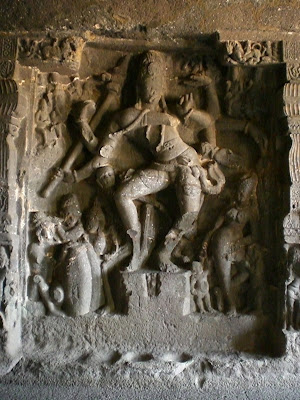
Not that we sat for hours discussing things in these terms, but we did talk quite a bit, or rather he talked quite a bit and I responded, and it became clear to me that we stand as opposites. For example, when we talked about the recurrence of symmetry in human works at Kailasanatha he held that humans imitate symmetry in nature; I held that very few things in nature are symmetrical and those that appear so are not upon close observation, so humans are trying to give body to an idea with the works of their hands. In life, this boiled down to opposing principles of action; he feels that human appetites should be gratified because appetite is the prime characteristic of human life and desire, while I feel that appetite only perpetuates more appetite, so we should discipline ourselves in order to escape being ruled by our lower aspects.
On an even more mundane level, our differences were reflected in our attitudes to Wikipedia. Both he and I frequently reference Wikipedia and agree that it's a brilliant and significant development. I feel compelled to credit Wikipedia as an invaluable resource in my writings here; I cannot carry an encyclopedia on my travels, but I often need to check my facts and supplement locally gathered details. For me, it is a source of information, but information is not an end in itself. The idea is to make something out of the information. For Csaba, seeing material life as an end, information is enough. When he emails his friends, he simply tells them where he went and includes a Wikipedia link to the place.
In either case, materialism or idealism, indulging appetites or denying them causes one to be aware of what they are, and so results in people with developed tastes. For a few days we shared our mutual regard for quality, beauty, thought and conversation; for me, it’s more important that a person has thoughts and can discuss them than the conclusions of the thoughts themselves. Or at least that holds to a certain point, to the point where their basis becomes clear and further conversation can only be a repetition on the theme. Then, you have to remain respectful but separate, because two people who are in fundamental dischord can only take each other so far. This is a strange obstacle that I often encounter, and is also the idea that lets me bid final goodbyes to so many people without desire or regret; I find I can only speak about the things that I hold most true, most important, to people who already know them.
Csaba and I left Aurangabad together on a night train, and we spent the following day in Mumbai, waiting for the night train south to Goa. When we reached Goa, we parted amicably and exchanged addresses. The very most I can say with absolute certainty, we are what we are. He sits now on another beach, indulging his appetites I’m sure; and I sit here, in Palolem, considering mine.













